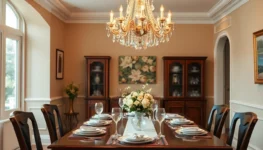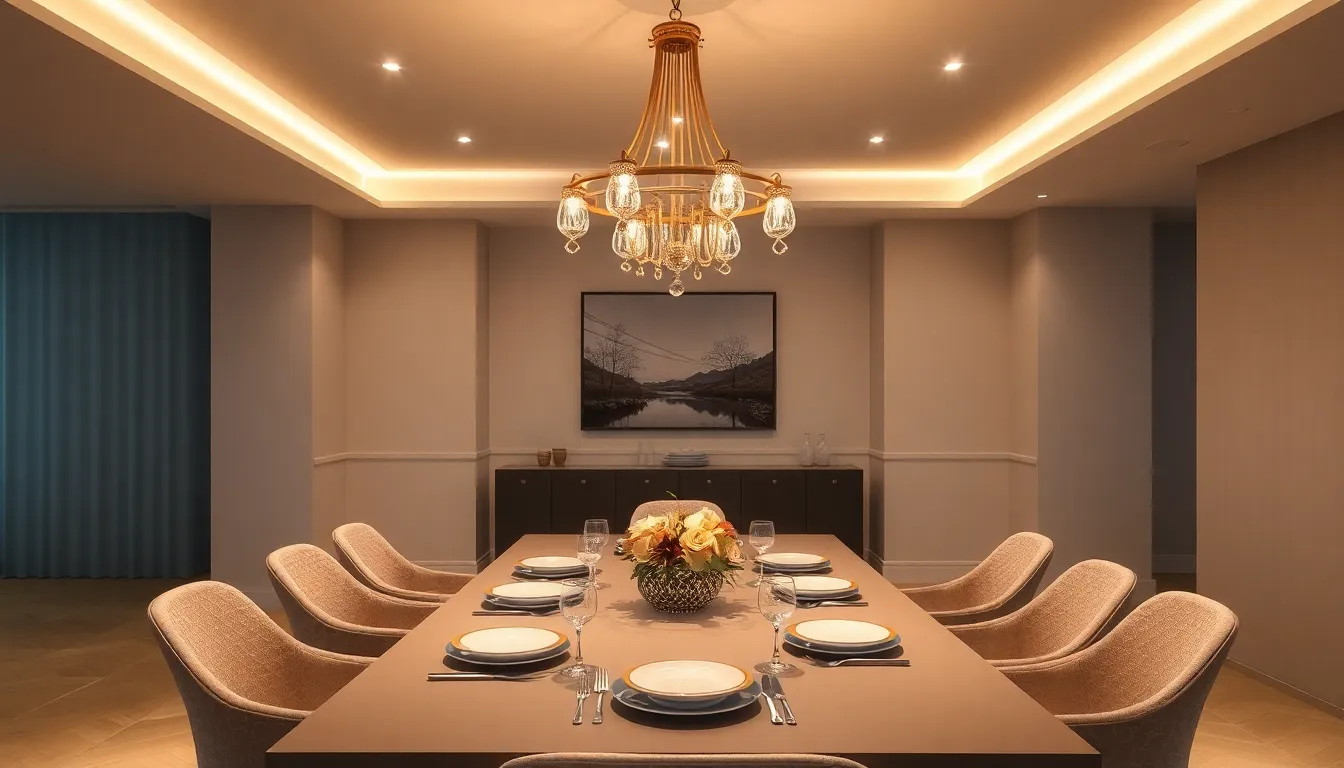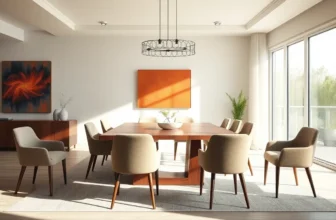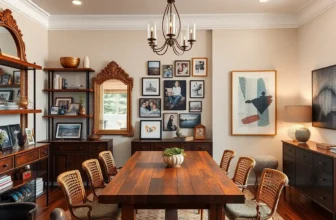
Ultimate Guide to Choosing the Best Dining Room Lights for Every Occasion
The right dining room lights can transform an ordinary meal into an extraordinary experience. Lighting sets the mood for gatherings, intimate dinners, and celebrations, making it a crucial element in home design. Whether it’s a modern chandelier or a rustic pendant, the choice of lighting can reflect personal style and enhance the overall ambiance.
In today’s world, where aesthetics and functionality go hand in hand, selecting the perfect lighting fixture involves more than just picking something pretty. It’s about creating a warm and inviting atmosphere while ensuring adequate illumination for dining activities. This guide explores various types of dining room lights, offering insights on how to choose the best options for every space, style, and occasion.
Dining Room Lights
Choosing the right type of dining room lights enhances both functionality and aesthetics. Various options suit different styles and needs.
Chandeliers
Chandeliers serve as focal points in dining rooms, providing both illumination and elegance. They come in various styles, including traditional, modern, and rustic. Styles typically include crystal, metal, and wood finishes, each creating distinct atmospheres. Size matters; larger dining areas benefit from larger chandeliers with multiple arms, while smaller spaces require more compact designs.
Pendant Lights
Pendant lights offer versatility and style, hanging individually or in clusters above dining tables. They create a direct light source, perfect for illuminating dining areas. Styles range from industrial to contemporary, allowing personalization. Height adjustment is essential; pendant lights should hang 30 to 36 inches above the tabletop for optimal effect.
Wall Sconces
Wall sconces add ambient lighting and create a cozy atmosphere in dining rooms. They work well in pairs, flanking mirrors or artwork. Styles vary, with options in vintage, modern, and minimalist designs. Placement is key; sconces should typically be mounted 60 inches above the floor for ideal visibility and balance.
Ceiling Lights
Ceiling lights provide overall illumination for the dining room, ensuring the space is well-lit. Types include flush mounts, recessed lights, and track lighting. Flush mounts suit lower ceilings, while recessed lights blend seamlessly into modern designs. Track lighting offers adjustability for highlighting specific areas, like artwork or buffet tables. Ample wattage ensures sufficient brightness for dining activities.
Choosing The Right Dining Room Lights

Choosing the right dining room lights requires careful consideration of several factors, including space size, decor style, brightness, and functionality. These elements ensure a harmonious blend of aesthetics and practicality.
Consider The Size Of Your Space
Considering the size of the dining room is crucial for selecting appropriate lighting. For small dining areas, compact fixtures such as pendant lights or flush mount ceiling lights enhance functionality without overwhelming the space. Larger dining rooms benefit from statement fixtures like chandeliers, which serve as focal points while providing ample illumination. It’s advisable to maintain a proportionate relationship; for example, a chandelier should be placed at least 30 inches above the table, ensuring enough clearance for diners.
Match The Style With Decor
Matching the lighting style with existing decor elevates the overall ambiance. Contemporary spaces may feature sleek, minimalist pendant lights, while traditional rooms often incorporate ornate chandeliers or classic wall sconces. Transitional styles blend elements from different eras, making versatile designs essential. For example, a modern fixture can complement vintage furniture if the materials and colors align cohesively. Always ensure that the selected light fixture enhances the room’s character rather than clashes with it.
Brightness And Functionality
Brightness levels significantly impact the dining experience, accommodating various activities from casual family meals to formal dinners. Choosing fixtures with adjustable brightness, such as dimmable LED lights, offers flexibility. Opting for multiple lighting sources—such as combining a central chandelier with wall sconces—creates layered illumination, enhancing both aesthetics and practical visibility. It’s essential to ensure that the chosen lighting provides adequate brightness for dining activities while creating a warm and inviting atmosphere.
Installation Tips For Dining Room Lights
Proper installation maximizes the effectiveness of dining room lights. These tips guide both DIY enthusiasts and those considering professional help.
Hire A Professional vs. DIY
Evaluate expertise before deciding on installation. Hire a professional when electrical work requires knowledge of safety codes, or when the project involves complex fixtures. Professionals ensure adherence to safety standards and code compliance, reducing risks associated with improper installation. Consider DIY for simpler projects, like replacing existing fixtures or installing low-weight pendants. Useful resources, including instructional videos and guides, are available online for DIY tasks.
Placement And Height Guidelines
Follow specific height guidelines for an ideal setup. Install chandeliers approximately 30 to 36 inches above the dining table for visibility without obstruction. For pendant lights, maintain a height of 28 to 34 inches above the table, ensuring they provide adequate illumination while allowing a clear line of sight. Wall sconces function best when placed 60 to 66 inches from the floor, casting light evenly throughout the room. Adjustments are necessary for rooms with high ceilings; raise the fixtures proportionally to maintain visual balance. Proper placement enhances both ambiance and functionality, ensuring a pleasant dining experience.
Maintenance And Care For Dining Room Lights
Maintaining dining room lights ensures longevity and optimal performance. Regular care enhances the dining atmosphere and keeps fixtures looking their best.
Cleaning Techniques
Cleaning techniques vary by fixture type. He or she must regularly dust chandeliers and pendant lights using a microfiber cloth. For glass shades, a mixture of mild soap and warm water effectively removes grime. It’s crucial that one avoids harsh chemicals, as they can damage finishes.
Wipe down wall sconces and ceiling lights with a damp cloth and mild soap. Assess the specific materials used; metal finishes often require specific care such as polishing with a suitable cleaner to prevent tarnish. Always ensure lights are turned off and cooled before cleaning to avoid burns or damage.
Bulb Replacement Tips
Bulb replacement tips help maintain brightness and efficiency. He or she should always turn off the power before changing bulbs to ensure safety. When selecting new bulbs, consider the fixture’s specifications, including wattage and bulb type.
LED bulbs often provide the best energy efficiency and longevity. It’s beneficial to stock up on commonly used bulb types to avoid inconvenience. For recessed or unusual fixtures, refer to the manufacturer’s guidelines to ensure compatibility. Check for proper seating in fixtures after installation, ensuring secure connections for optimal performance.
Selecting the right dining room lights can transform any meal into a memorable experience. By thoughtfully considering style and functionality, one can create a welcoming atmosphere that reflects personal taste. The interplay of various lighting types not only enhances the room’s aesthetic but also ensures adequate illumination for dining activities.
With careful planning and attention to detail, it’s possible to achieve a balanced and inviting space. Whether opting for a stunning chandelier or versatile pendant lights, the right choices will elevate the dining experience. Regular maintenance and proper installation further ensure that these fixtures shine brightly for years to come. Embracing these principles will lead to a beautifully lit dining area that delights both hosts and guests alike.




